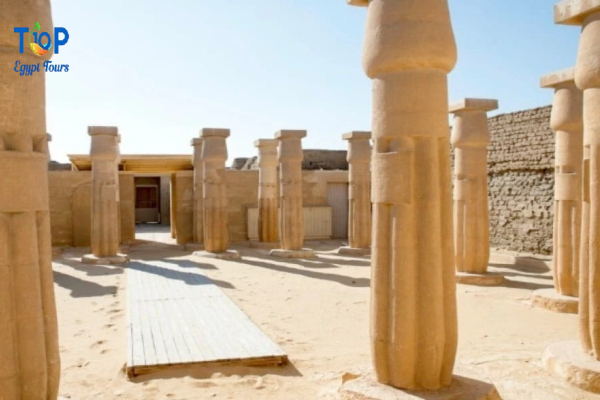The Memphite Tomb of Horemheb, located in Saqqara, Egypt, is an ancient burial site that provides valuable insights into the funerary practices and beliefs of ancient Egypt. Horemheb, who reigned as the last pharaoh of the 18th Dynasty, commissioned this tomb during his reign in the New Kingdom period. The tomb complex is renowned for its architectural features, intricate reliefs, and historical significance, offering a fascinating glimpse into the life and afterlife of an Egyptian pharaoh.
In this article, we will uncover for you The Memphite Tomb of Horemheb with Top Ten Egypt.
Historical Background
Horemheb ruled Egypt from around 1319 to 1292 BCE and played a significant role in the political and religious restoration of the country following the controversial reigns of Akhenaten and Tutankhamun. As a military general under Tutankhamun and Ay, Horemheb eventually ascended to the throne and initiated a series of reforms to stabilize Egypt. He sought to reinstate traditional religious practices and restore the power of the priesthood and the authority of the pharaoh.
Architecture and Design
Memphite Tomb of Horemheb in Saqqara is an impressive complex that reflects the grandeur and symbolism associated with royal tombs in ancient Egypt. The tomb’s design follows the traditional architectural style of the period, featuring an entrance hall, corridors, chambers, and a burial chamber.
The entrance hall, known as the “Pillared Hall,” is notable for its decorated columns and reliefs depicting scenes from Horemheb’s life and religious rituals. The corridors leading to the burial chamber are adorned with intricate carvings and hieroglyphic inscriptions, providing insights into the pharaoh’s journey to the afterlife.
Wall Reliefs and Decorations
The tomb’s walls are adorned with elaborate reliefs that depict various aspects of Horemheb’s life, religious ceremonies, and funerary rituals. These reliefs serve as a visual narrative, offering valuable information about the pharaoh’s achievements, his relationship with the gods, and his preparations for the afterlife.
One of the striking features of the reliefs is the portrayal of Horemheb engaged in religious activities, such as making offerings to deities, participating in purification rituals, and performing rituals associated with the rejuvenation of the deceased. These scenes highlight the pharaoh’s role as a mediator between the mortal world and the divine realm.
Significance and Exploration of The Memphite Tomb of Horemheb
The Memphite Tomb of Horemheb is of great archaeological and historical significance. It provides scholars and visitors with valuable insights into the religious beliefs, burial practices, and royal iconography of ancient Egypt during the New Kingdom period.
Exploration and excavation of the tomb have uncovered a wealth of artifacts, including statues, jewelry, and funerary equipment. These discoveries have contributed to our understanding of the material culture and burial customs of the time.
Visiting the Memphite Tomb of Horemheb
As an archaeological site, access to the Memphite Tomb of Horemheb may be restricted at certain times or require a guided tour. Visitors are advised to check the availability and accessibility of the tomb before planning a visit.
When visiting the tomb, it is essential to respect the site’s historical and cultural significance. Photography restrictions may apply, and visitors should adhere to any guidelines or rules set by the authorities overseeing the tomb.
Conclusion
The Memphite Tomb of Horemheb stands as a testament to the artistic and architectural achievements of ancient Egypt. Its reliefs, decorations, and historical significance provide valuable insights into the life and funerary practices of Horemheb, the last pharaoh of the 18th Dynasty. For history enthusiasts, archaeology lovers, and those fascinated by ancient Egypt, a visit to the Memphite Tomb of Horemheb offers a unique opportunity to step back in time and explore the rich cultural heritage of this captivating civilization.



Comment (0)